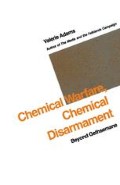Abstract
In the years following the First World War, there emerged within the United States the tension which has in different forms continued as an element of American chemical warfare policy to present times.1 In the early 1920s, the public, inspired in part by the horrors of the war and in part by the excesses of a campaign by the chemical industry to win support for chemical weapons production, strongly favoured a ban on chemical weapons. The US War Department, suspicious of chemical warfare, doubtful about its value, and with other expenditure priorities, sought to disband the Chemical Warfare Service (CWS) and to limit CW activities to those strictly necessary for defence and retaliation. Congress, however, backed the CWS in its attempt to maintain and improve a CW combat capability that was not necessarily restricted to retaliation.2
Access this chapter
Tax calculation will be finalised at checkout
Purchases are for personal use only
Preview
Unable to display preview. Download preview PDF.
Notes
Walter Schneir, ‘The Campaign to Make Chemical Warfare Respectable’, The Reporter, 1 October 1959, p. 24.
B.H. Liddell Hart, ‘Is Gas a Better Defence than Atomic Weapons?’ Survival, September/October 1959, pp. 139–42.
General Rogers, Hearings before the Committee on Appropriations, United States Senate, Department of Defense, Appropriations for 1980, pp. 840–1; Major General N.J. Fulwyler, before the House Committee on Armed Services, Hearings on Military Posture and HR 5968, p. 838.
Patrick Forbes, ‘Low-key Sortie to UK about “Big-eye” Bomb’, New Statesman, 5 April 1985.
Lois R. Ember, ‘Battle Looms Over Funding of Binary Chemical Weapons’, Chemical and Engineering News, 11 August 1986.
Susan Wright, ‘The Military and the New Biology’, Bulletin of the Atomic Scientists, May 1985, pp. 10–16.
Dr Haase Ewin, ‘Chemical and Biological Warfare: The New Frontier’, Asian Defence Journal, June 1986, pp. 84–6.
Copyright information
© 1989 Valerie Adams
About this chapter
Cite this chapter
Adams, V. (1989). ‘An Armed and Agile Nation’. In: Chemical Warfare, Chemical Disarmament. Palgrave Macmillan, London. https://doi.org/10.1007/978-1-349-08903-1_7
Download citation
DOI: https://doi.org/10.1007/978-1-349-08903-1_7
Publisher Name: Palgrave Macmillan, London
Print ISBN: 978-1-349-08905-5
Online ISBN: 978-1-349-08903-1
eBook Packages: Palgrave Political & Intern. Studies CollectionPolitical Science and International Studies (R0)

